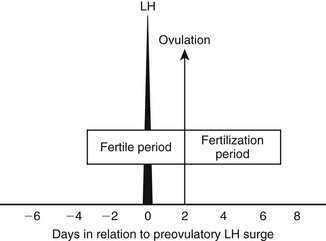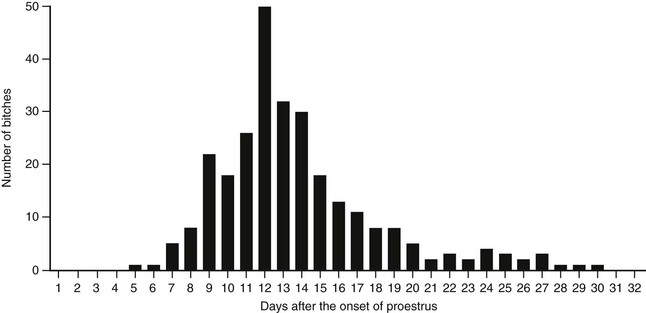Chapter 204 For all species the fertilization period is the time when oocytes are available to be fertilized. In the bitch this period commences 2 days after ovulation and extends until approximately 5 days after ovulation (Figure 204-1). The fertilization period is the time of maximal fertility, which declines rapidly over the next few days because of degeneration of the oocytes and closure of the cervix, the latter of which prevents sperm from entering the reproductive tract. Figure 204-1 Schematic relationship among the fertilization period, fertile period, ovulation, and the luteinizing hormone surge. The fertile period is the time during which a breeding could result in a conception. Therefore it includes the fertilization period, but it also precedes the fertilization period by several days because sperm can survive within the female reproductive tract (see Figure 204-1). In some stud dogs, sperm can survive for up to 7 days within the reproductive tract of some females. In this situation, the fertile period commences 5 days before ovulation (i.e., sperm surviving for 7 days fertilize oocytes 2 days after ovulation). The period of peak fertility for natural breeding with fertile animals ranges from the day of ovulation until 4 days after ovulation (Table 204-1). The period of peak fertility commences before the true fertilization period because sperm are required to mature within the female reproductive tract; this process of capacitation may take approximately 6 hours or more. Litter size does not seem to depend on which of these days that bitches are mated. Breedings earlier or later commonly result in lower pregnancy rates and smaller litters. For the accurate prediction of the optimal time to breed, either the day of the onset of LH surge or ovulation should be identified. However, identifying these events can be challenging and imprecise. TABLE 204-1 Timing of Events in Relation to the Luteinizing Hormone Surge and Ovulation in the Bitch Modified from England GCW, Concannon PW: Determination of the optimal breeding time in the bitch: basic considerations, accessed Sept 1, 2002, from www.ivis.org. Many breeders rely on counting the number of days from the onset of proestrus and believe that bitches ovulate a defined number of days from the onset of this event. This is not the case for all breeds (Figure 204-2). The duration of proestrus is variable among bitches (3 to 21 days). Although the “average bitch” may ovulate 12 days after the onset of proestrus, some bitches ovulate as early as day 5, and others as late as day 30 after the onset of proestrus. Figure 204-2 The relationship between day of ovulation and the onset of proestrus for normal fertile bitches. In some species the onset of the behavioral signs of estrus (acceptance of mating) can be used to determine the optimal time for breeding. However, in the bitch there is often a poor correlation between endocrine events and behavioral events. Studies on laboratory-kept bitches suggest that the onset of standing estrus occurs, on average, at the same time as the onset of the LH surge (Concannon et al, 1977). Using these data, 3 or 4 days after the onset of standing estrus would be a suitable time for mating. However, as stated previously, in many other bitches the behavioral responses correlate poorly with the underlying hormonal events. This may be because bitches are housed away from the male and introduced only when the breeder considers the time to be correct, thus inhibiting natural courtship responses; or it simply may represent greater variation than was thought originally. A further complication is that in some bitches the behavioral changes may be displayed poorly and therefore the onset of estrus may be indistinct.
Breeding Management of the Bitch
Reproductive Physiology
The Fertilization Period

The Fertile Period
The Optimal Time for Breeding
Event
Days from Luteinizing Hormone Surge
Days from Ovulation
Period of potential fertility: the fertile period
3 days before LH surge until 7 days after LH surge
5 days before ovulation until 5 days after ovulation
Approximate time of oocyte maturation
4 or 5 days after LH surge
2 or 3 days after ovulation
Period of actual fertility: the fertilization period
4 or 5 days after LH surge until 7 days after LH surge
2 or 3 days after ovulation until 5 days after ovulation
Period of peak fertility
2 days after LH surge until 6 days after LH surge
The day of ovulation until 4 days after ovulation
Preferred breeding time using natural service or fresh semen insemination
2 days after LH surge until 6 days after LH surge
The day of ovulation until 4 days after ovulation
Preferred breeding time for males with poor quality semen or frozen-thawed semen insemination
5 to 6 days after LH surge
3 to 4 days after ovulation
Observational Assessments
The Number of Days from the Onset of Proestrus

The Onset of Estrous Behavior
![]()
Stay updated, free articles. Join our Telegram channel

Full access? Get Clinical Tree


Breeding Management of the Bitch
Only gold members can continue reading. Log In or Register to continue
